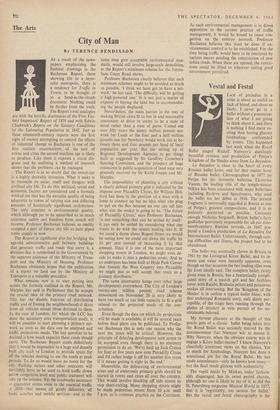Vestal and Festal
La Bayadere is close to the heart of every Russian ballet lover, and for that matter lover of Russian ballet. Choreographed in 1877 by Petipa for his favourite ballerina Ekaterina Vazem, the leading role of the temple-dancer Nikiya has been associated with many ballerinas including Pavlova and Spessivtseva, who used the ballet for her debut in 1916. The present fragment is universally regarded in Russia as one of Petipa's greatest compositions, and it is as jealously preserved as possible. Curiously enough Nicholas Sergueeff, British ballet's fairy godfather previously responsible for all our nine- teenth-century Russian revivals, in 1947 pre- pared a London production of La Bayadere for International Ballet. Unfortunately, through cast-. ing difficulties and illness, the project had to be abandoned.
The ballet was eventually shown in Britain in 1961 by the Leningrad Kirov Ballet, and its in- terest and value were instantly apparent, even though on that occasion the t'wo leading roles were far from ideally cast. The complete ballet, rarely given even in Russia, has a fantastically compli- cated story of a nautch girl and her faithless lover, with Rajahs, Brahmin priests and poisonous snakes all intervening. But the 'Kingdom of the Shades' is in outline a typical ballet blanc, with that archetypal Romantic story, only dimly per- ceptible, of the tragic hero running through the glades of mystery in vain pursuit of his un- obtainable beloved. .
My fervent pleasure at the thought of this pearly gem of a classic ballet being taken into the Royal Ballet was seriously marred by the announcement that Nureyev was to mount it. Why Nureyev, when the obvious course was to engage a Kirov ballet-master? I knew Nureyev's cheerfully irreverent views on the classics. Yet so much for forebodings. Nureyev has done a sensational job for the Royal Ballet. He has made amendments—only he knows how many— but the final result glistens with authenticity.
The vapid music by Minkus, today fashion- ably disparaged, has its sweet period charms, although no one is likely to say of it, as did the St. Petersburg magazine Musical World in 1877, that it is 'regrettably, too serious for ballet.' But the vestal and festal choreography is the
thing, and, admirably set off by Philip Prowse's handsome costumes and William Bundy's power- house lighting, the Royal Ballet dance it almost sumptuously well, even if one trusts they will dance it rather better in fifty years' time.
Fonteyn, smiling elusively and dancing with a glorious elegance, showed off a bravura brilli- ance and opalescent glow that were heartrend- ingly beautiful. The three subsidiary ballerinas, Monica Mason, Merle Park and Lynn Seymour, danced with a subtly dazzling style, and the
ensemble, whether descending their ramp in the ballet's opening coup de theeltre of a myriad of penche arabesques or grouping stylishly in the background, was almost Kirovsky. As for our benefactor, Nureyev, he seemed like a god of the air, and was hardly less godlike when a human falter spoilt the ending of his first-night, but not his second-night, solo. The next test comes when two British boys take over his role. My fingers are already crossed for them.
CLI VE BARNES







































 Previous page
Previous page